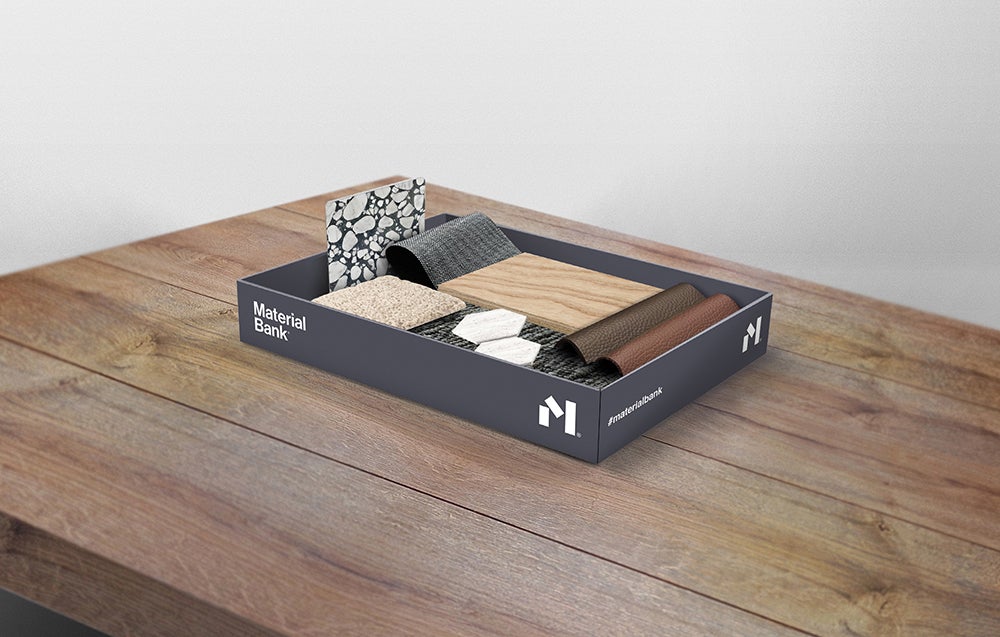For Michele McMinn, senior associate at architectural design firm Gresham Smith, the benefits of a business relationship with Material Bank were obvious from the outset. Based in Nashville, Tennessee, with satellite offices throughout the Southeastern United States, Gresham Smith oversees major construction projects across multiple industries: corporate and urban, mixed-use, industrial, aviation and health care. Each is its own puzzle, presenting the challenge of putting together a million little pieces to complete one cohesive whole—and to do so in the most sustainable manner possible. Anything that streamlines the product-sampling process while also aligning with the company’s commitment to a smaller carbon footprint is a must-do.
“Material Bank allows us to have a more straightforward workflow across distances,” says McMinn.
Free for design pros, the Material Bank online marketplace consolidates the collections of hundreds of brands, from Ann Sacks, Vadara Quartz and Artistic Tile to United Fabrics and Zandur. Categories include bathroom appliances, insulation systems, seating, storage, acoustical solutions and window treatments—a true soup-to-nuts of project needs. By simplifying search across so many manufacturers and materials, the site eliminates countless hours of comparison shopping and a computer screen full of open tabs. Place an order by midnight Eastern time, and all samples will arrive in a single box by 10:30 the next morning. It’s that easy.
Plus, the service has a surprising upside in this new era of remote work: “By sending these curated packages to clients, we’re able to present virtually. The designer doesn’t have to be there in person,” says McMinn.
Gresham Smith began its partnership with Material Bank long before COVID-19, joining the platform as one of 14 companies participating in its pilot program, which was targeted at reducing carbon offset. Once the pandemic took hold, the service “became a lifeline,” says McMinn, because it made it possible for teams to continue working without having to be in the office or on the job site. Most recently, the firm turned to Material Bank when fast-tracking a 500,000-square-foot project for a top tech company in Tennessee. “People want to touch and feel the materials, get a sense of the actual color and texture—aspects that don’t come across on screen,” says McMinn. “With Material Bank, everyone involved can evaluate these qualities together, no matter where they’re located.”
To make sample selection as simple and informative as possible, Material Bank employs a series of smart tools. Designers can narrow their search by applying more than 160 filters: brand, color, pattern, price, third-party certification and so on. They can then save those criteria to use as shortcuts for recurring searches. Along with photos, each product page includes downloadable details about the item’s composition, performance and environmental impact; brand pages also offer a big-picture view of the manufacturer’s design mission. Palettes specific to a singular project or space can be grouped, saved, and shared with team members via customized boards. If any questions remain, designers can “ask an expert” via online chat, and the vendor directory provides instant access to sales reps.
“We were looking at building these terra cotta–clad banquettes,” says McMinn, citing one example. “We wanted a great hospitality fabric and this particular color. The search function on Material Bank enabled us to nail down our options much more quickly.”
Aside from the endless variety of samples, Material Bank offers something else of increasing value to the design community: a commitment to carbon neutrality. The company’s proprietary packaging utilizes minimal peanuts and Bubble Wrap. Prepaid return packs further reduce waste by reusing rather than recycling samples and display trays. And by tracking metrics like the average number of packages per order—both in aggregate for a business and broken down by location—Material Bank helps clients calculate how much carbon they’re saving. The idea is that the more that can be combined into one order (one box), the better for the planet. “It’s pretty cool and very informative, and it lets you know where you need to improve,” says McMinn, who reports that Gresham Smith’s Chicago office averages 4.5 packages saved per order. The firm’s arrangement with Material Bank helps it achieve its internal goals to minimize its footprint.
Even as the pandemic abates, travel resumes to some extent, and businesses begin adapting to hybrid office models, remote work is likely here to stay—and the most productive methods to facilitate it will continue to gain traction. “Having 25 packages of samples show up from individual carpet, tile, and wallcovering manufacturers, or even just having six separate packages from six different wallcovering vendors alone—who would ever want to go back to that?” says McMinn. The one-stop-shop convenience of Material Bank makes it all seamless.
“It brings efficiency to material selection,” she says. “You open one box, not 100.”
This story is a paid promotion and was created in partnership with Material Bank.
Homepage photo: A box of samples from Material Bank | Courtesy of Material Bank





























